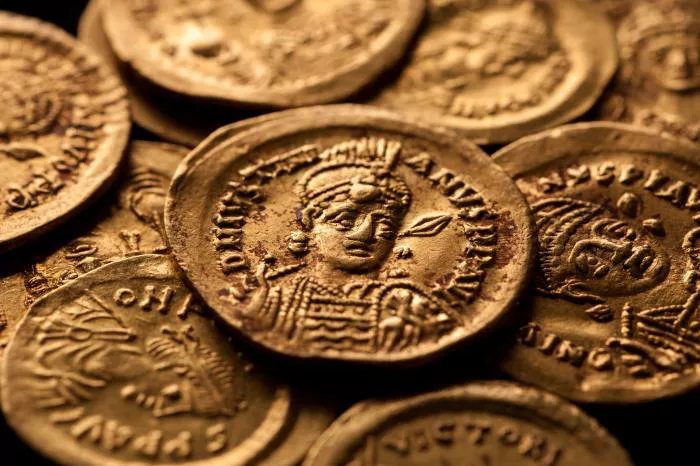TASHKENT – In a joint operation conducted by the State Security Service (SSS) and customs officials, two men have been arrested for attempting to sell 100 antique gold coins valued at $67,000. The two suspects, identified as A.H., a 57-year-old resident of Tashkent’s Almazar district, and E.S., a 60-year-old from Andijan, were caught in the act of completing the illegal sale.
The coins, minted between 1897 and 1911, hold significant historical and cultural value and were sought after for their rarity and purity. Authorities have opened a criminal case against the suspects, charging them under Uzbekistan’s laws against illegal currency trade.
Arrest During Sale Transaction
The joint operation unfolded when authorities apprehended A.H. and E.S. during the transaction. A.H., who was in possession of the gold coins, was attempting to sell them to E.S. at the time of the arrest. The sale, which took place in Tashkent, was closely monitored by law enforcement after receiving intelligence about the illegal transaction.
Authorities acted swiftly to detain both suspects before they could finalize the deal, seizing the coins and preventing their illegal sale. This action underscores the seriousness with which Uzbekistan handles cases of illegal currency and artifact trading.
Historical Significance of the Coins
A detailed inspection of A.H.’s vehicle led to the discovery of additional gold coins. In total, authorities recovered 37 more coins, bringing the overall number of coins seized to 137. According to experts, these coins were minted between 1897 and 1911 and bear denominations of 5 and 10 rubles. They are composed of high-purity gold, with purities of 900 and 916. The total weight of the coins is 776 grams, further emphasizing their value and significance.
The historical and artistic value of these coins cannot be overstated. They are considered cultural artifacts due to their age, rarity, and the craftsmanship involved in their minting. Popularly referred to as “Nikolaev” coins, they were named after Tsar Nicholas II, who ruled Russia during the period when the coins were minted. These coins are highly coveted by collectors and investors alike due to their connection to the final years of the Russian Empire and their exceptional gold content.
Estimated Value and Planned Resale in Kyrgyzstan
Authorities estimate the value of the recovered coins at approximately 950 million Uzbek soums, or $67,000. This value is based on the historical significance, weight, and gold purity of the coins. Given the rarity of such artifacts, the coins could have fetched even higher prices on the black market, where demand for antique gold is strong.
E.S., one of the suspects, had reportedly planned to transport the coins to Osh, Kyrgyzstan, where he intended to resell them. Osh, a city with a vibrant trading community, is known for its bustling markets, which are sometimes linked to illegal trade in valuable goods. The coins would likely have been sold for a significant profit, making the transaction particularly lucrative for those involved.
Legal Implications and Criminal Charges
Following the arrest of A.H. and E.S., authorities have launched a criminal investigation into the case. The two men have been charged under Article 177, part 4, section “a” of the Criminal Code of Uzbekistan. This article deals specifically with the illegal acquisition or sale of foreign currency in especially large amounts. In this case, the antique gold coins, while technically not currency in circulation, fall under this law due to their significant value and potential use in illegal transactions.
The charges the men face are severe, as Uzbekistan has strict laws governing the trade of cultural artifacts and foreign currency. If found guilty, A.H. and E.S. could face lengthy prison sentences, heavy fines, or both. The outcome of the investigation will determine the exact penalties they will face.
Investigation and Broader Concerns Over Artifact Smuggling
The investigation is ongoing as authorities work to gather more information about the origins of the coins and the network behind the attempted sale. Law enforcement is particularly interested in uncovering whether the two suspects were acting alone or as part of a larger organized group involved in smuggling artifacts and foreign currency.
Uzbekistan has seen a rise in attempts to smuggle cultural artifacts and rare items out of the country in recent years. With its rich history and proximity to other regions known for artifact smuggling, Uzbekistan has become a target for individuals seeking to profit from the illegal trade of historically significant items. The arrest of A.H. and E.S. highlights the ongoing efforts of the country’s security services to crack down on this illicit trade.
Authorities have made it clear that they will continue to pursue individuals and groups involved in the illegal sale of cultural artifacts, particularly when these items are linked to Uzbekistan’s heritage or the region’s broader historical significance. The protection of the country’s cultural treasures remains a top priority for law enforcement.
Conclusion: Serious Charges Await the Suspects
The arrest of A.H. and E.S. for attempting to sell antique gold coins has brought attention to the broader issue of artifact smuggling in Uzbekistan. The coins, with their rich historical background and significant value, were likely destined for sale on the black market, but law enforcement intervened in time to prevent their illegal transfer.
As the investigation continues, the two men face serious charges under Uzbekistan’s strict currency and artifact trade laws. Their case serves as a reminder of the ongoing efforts by authorities to combat the illegal trade of cultural artifacts, protecting the country’s heritage for future generations. The swift action taken by the State Security Service and customs officials in this case demonstrates the commitment of Uzbekistan’s law enforcement agencies to safeguarding the nation’s cultural and historical assets.
Related topics:

